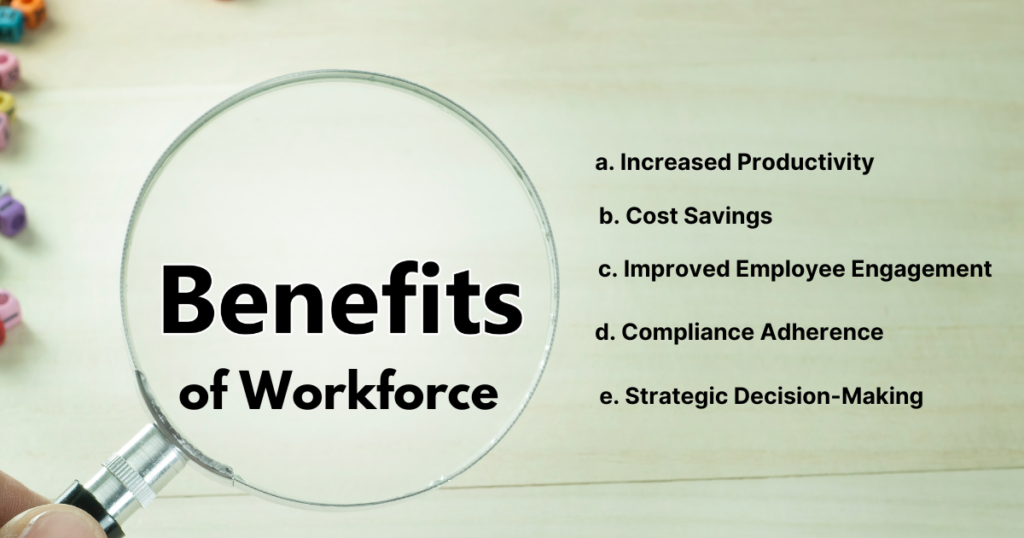Workforce Management: Optimising Human Capital for Organisation Success
In today’s dynamic business environment, effective management of human capital is critical for organizational success. Workforce management encompasses a strategic set of processes and practices aimed at maximizing the productivity, engagement, and well-being of employees. This article provides a deep dive into the concept of workforce management, exploring its definition, core functions, benefits, real-world applications, challenges, engagement strategies, and overall impact on business performance.
I. Definition and Core Functions
At its essence, workforce management involves the strategic allocation and utilization of workforce resources to achieve business objectives. Its core functions include:
- Scheduling Optimization: Efficient scheduling is crucial for balancing workload demands and employee availability. Workforce management systems use data analytics and forecasting algorithms to create optimized schedules that align with business needs and employee preferences.
- Time and Attendance Management: Accurate tracking of employee hours, attendance, and leave is essential for payroll accuracy and compliance. Workforce management solutions automate time-tracking processes, reducing errors and ensuring regulatory compliance.
- Performance Monitoring: Evaluating employee performance and providing feedback is integral to workforce management. Performance management tools facilitate goal setting, performance reviews, and development plans to enhance employee productivity and engagement.
- Payroll and Compensation: Managing payroll, benefits, and compensation involves complex calculations and compliance with labor laws. Workforce management systems integrate payroll functionalities, ensuring timely and accurate payments while minimizing errors.
- Data Analytics and Reporting: Leveraging workforce data for insights drives informed decision-making. Advanced analytics tools provide actionable insights into productivity trends, labor costs, and workforce efficiency, enabling strategic workforce planning.
II. Benefits and Impact of Workforce Management

Effective workforce management yields several benefits for organizations:
a. Increased Productivity:
Optimized schedules, clear performance expectations, and targeted training programs contribute to higher productivity levels among employees.
b. Cost Savings:
Efficient resource allocation reduces overtime expenses, and streamlined processes lead to cost savings and improved profitability.
c. Improved Employee Engagement:
Engaged employees are more motivated, committed, and innovative, resulting in higher job satisfaction and retention rates.
d. Compliance Adherence:
Workforce management systems ensure compliance with labor laws, regulations, and industry standards, reducing legal risks and penalties.
e. Strategic Decision-Making:
Data-driven insights enable organizations to make informed decisions about staffing levels, skill development, and organizational priorities, driving business growth.
III. Real-World Applications of Workforce Management
Let’s explore how workforce management is applied across various industries:
a. Healthcare:
Hospitals use workforce management to schedule nurses, and patient engagement specialists, manage patient loads, and comply with staffing ratios. This improves patient care quality, reduces wait times, and enhances staff satisfaction.
b. Retail:
In retail, workforce management optimizes staffing based on sales forecasts, customer traffic patterns, and promotional events. This ensures adequate coverage during peak hours and minimizes labor costs during slower periods.
c. Manufacturing:
Workforce management in manufacturing focuses on optimizing production schedules, managing shift rotations, and tracking labor costs. This results in increased output, reduced downtime, and improved operational efficiency.
d. Hospitality:
Hotels and restaurants use workforce management to schedule staff, manage reservations, and adapt to seasonal demand fluctuations. This ensures excellent customer service and efficient operations.
e. Service Industries:
Workforce management is crucial in service-oriented industries like IT, where project staffing, skill matching, and resource allocation impact project delivery and client satisfaction.
IV. Data-Driven Insights and Statistics
According to a survey by Deloitte, companies with effective workforce management practices experience 21% higher profitability and 23% higher employee engagement.
The Bureau of Labour Statistics reports that organizations using workforce management systems reduce absenteeism rates by 25% and turnover rates by 15%.
A study by McKinsey & Company found that optimized workforce scheduling can lead to a 10-15% reduction in labor costs and a 20-25% increase in productivity.
These statistics highlight the tangible impact of workforce management on organizational performance and employee outcomes.
V. Challenges in Workforce Management and Solutions

Despite its benefits, workforce management presents several challenges:
a. Complexity of Scheduling:
Industries with dynamic scheduling needs, such as healthcare and retail, face challenges in creating flexible and efficient schedules. Solutions include automated scheduling algorithms, employee self-service portals, and predictive analytics.
b. Compliance and Regulations:
Adhering to labor laws, union agreements, and industry regulations requires continuous monitoring and compliance checks. Workforce management systems with built-in compliance features and audit trails help organizations stay compliant.
c. Integration with Existing Systems:
Integrating workforce management systems with HRIS, payroll, and ERP systems can be complex. Collaborative partnerships with vendors, data migration strategies, and system interoperability are key to successful integration.
d. Employee Resistance to Change:
Introducing new workforce management processes may face resistance from employees. Change management strategies, training programs, and communication plans can overcome resistance and drive adoption.
e. Workforce Diversity and Inclusion:
Managing diverse workforces requires inclusive policies, cultural awareness, and equitable opportunities. Workforce management strategies that consider diversity, equity, and inclusion promote a positive work environment and foster innovation.
VI. Engagement Strategies and Human-Centric Approaches
Engagement strategies are essential for motivating employees and driving performance:
a. Recognition and Rewards:
Acknowledging employee contributions through recognition programs, incentives, and awards boosts morale and reinforces desired behaviors.
b. Training and Development:
Investing in employee development, skills training, and career pathways demonstrates a commitment to employee growth and fosters loyalty.
c. Transparent Communication:
Open communication channels, regular feedback sessions, and town hall meetings promote transparency, trust, and collaboration.
d. Work-Life Balance Initiatives:
Offering flexible work arrangements, wellness programs, and support for work-life balance improves employee well-being and productivity.
VII. Empirical Evidence and Case Studies

Real-world case studies provide insights into the practical application and impact of workforce management:
a. Healthcare System Case Study:
A healthcare system uses workforce management tools to improve nurse staffing ratios and reduce patient wait times. The initiative resulted in a 15% increase in patient satisfaction scores.
b. Retail Chain Case study:
A retail chain implemented workforce management software to optimize schedules and reduce overtime costs. The solution led to a 20% increase in sales and a 30% decrease in labor expenses.
c. Manufacturing Company Case Study:
A manufacturing company leveraged workforce analytics to enhance production schedules and reduce downtime. The initiative led to a 25% increase in output and a 10% decrease in maintenance costs.
These case studies demonstrate the tangible benefits and ROI of workforce management initiatives across different industries.
VIII. Comparative Analysis and Industry Trends
Understanding the nuances of workforce management requires a comparative analysis of different approaches and industry-specific trends:
a. Workforce Management vs. Human Resources (HR):
Differentiating between workforce management and HR is essential to grasp their distinct roles and contributions to organizational success. While HR focuses on talent acquisition, training, and compliance, workforce management delves into optimizing work processes, scheduling, and resource allocation.
b. Industry-Specific Trends:
Each industry has unique workforce management challenges and trends. For example, in the retail sector, the rise of Omni channel retailing has increased demand for flexible scheduling and cross-trained employees. In healthcare, the aging population and healthcare reforms drive the need for optimized staffing levels and efficient patient care delivery.
c. Technological Advancements:
Emerging technologies such as AI, machine learning, and predictive analytics are reshaping workforce management practices. AI-driven scheduling algorithms, IoT-enabled workforce tracking, and virtual assistants enhance efficiency, accuracy, and decision-making in workforce management.
d. Remote Work and Hybrid Models:
The shift towards remote work and hybrid work models has implications for workforce management. Remote workforce management tools, collaboration platforms, and performance monitoring systems are essential for managing distributed teams effectively.
IX. Integration of Engagement Strategies
Engagement strategies are integral to workforce management and organizational culture. Let’s delve deeper into key engagement strategies and their impact:
a. Recognition and Rewards:
Implementing a robust recognition program that acknowledges achievements, milestones, and contributions fosters a culture of appreciation and motivates employees to excel.
b. Training and Development:
Investing in continuous learning opportunities, skill development workshops, and leadership programs not only enhances employee capabilities but also signals a commitment to their professional growth and career advancement.
c. Transparent Communication:
Transparent communication channels, regular feedback mechanisms, and open-door policies create a culture of trust, transparency, and collaboration. Employees feel valued, heard, and empowered to contribute ideas and feedback.
d. Work-Life Balance Initiatives:
Promoting work-life balance through flexible work arrangements, wellness programs, and family-friendly policies improves employee well-being, reduces burnout, and increases retention rates.
X. Impact on Organizational Culture and Performance Conclusion
Workforce management is a multifaceted discipline that integrates people, processes, and technology to optimize human capital and drive organizational success. By embracing data-driven insights, addressing challenges proactively, and implementing engagement strategies, organizations can unlock the full potential of their workforce and achieve sustainable growth in today’s competitive landscape.
a. Culture of Accountability:
Clear performance expectations, goal alignment, and performance metrics foster a culture of accountability where employees take ownership of their roles, deliver results, and contribute to organizational success.
b. Agility and Adaptability:
Agile workforce management practices enable organizations to respond swiftly to market changes, customer demands, and industry disruptions. Flexibility in scheduling, resource allocation, and talent deployment enhances agility and adaptability.
c. Innovation and Creativity:
Engaged and empowered employees are more likely to innovate, collaborate, and contribute creative solutions to business challenges. Workforce management practices that encourage experimentation, risk-taking, and knowledge-sharing drive innovation and competitiveness.
d. Employee Retention and Loyalty:
A positive work environment, meaningful work, and opportunities for growth and development are key factors in employee retention and loyalty. Workforce management strategies that prioritize employee well-being, recognition, and career advancement contribute to higher retention rates and reduced turnover costs.
XI. Future Outlook and Continuous Improvement
Looking ahead, the future of workforce management is characterized by ongoing evolution, technological advancements, and a focus on employee experience:
a. AI and Predictive Analytics:
AI-driven workforce management solutions will continue to revolutionize scheduling, resource allocation, and decision-making. Predictive analytics will enable organizations to anticipate workforce needs, identify trends, and optimize operations proactively.
b. Employee-Centric Approach:
An employee-centric approach to workforce management, emphasizing work-life balance, well-being initiatives, and personalized experiences, will be central to attracting and retaining top talent in a competitive market.
c. Remote Work and Hybrid Models:
The widespread adoption of remote work and hybrid work models will necessitate flexible workforce management solutions, collaboration tools, and performance measurement frameworks tailored to remote teams.
d. Continuous Learning and Development:
Lifelong learning, upskilling, and reskilling will be integral to workforce management strategies as industries undergo digital transformation and automation. Continuous learning platforms, microlearning modules, and personalized development plans will support employee growth and adaptability.
XII. FAQs about Workforce Management
1. What is workforce management, and why is it important for businesses?
Workforce management refers to the strategic approach of optimizing workforce resources to achieve organizational goals. It includes processes like scheduling, time management, performance monitoring, and payroll management. It’s crucial for businesses because it enhances productivity, reduces costs, improves compliance, and enables data-driven decision-making.
2. How does workforce management differ from human resources (HR)?
While HR focuses on talent acquisition, training, and compliance, workforce management is more about optimizing work processes, scheduling, and resource allocation to maximize efficiency and productivity. HR is broader in scope and deals with the entire employee lifecycle, while workforce management is more focused on operational efficiency.
3. What are some common challenges businesses face in implementing workforce management solutions?
Common challenges include complex scheduling requirements, compliance with labor laws and regulations, integrating workforce management systems with existing HRIS or ERP systems, employee resistance to change, and managing diverse workforces with different needs and preferences.
4. How can workforce management solutions benefit small businesses?
Workforce management solutions can benefit small businesses by improving productivity, reducing labor costs, ensuring compliance with regulations, automating time-consuming tasks like payroll and scheduling, and providing data-driven insights for strategic decision-making. They can also help small businesses adapt to changing market conditions and scale their operations efficiently.
5. What are some key trends shaping the future of workforce management?
Key trends include the adoption of AI and predictive analytics for smarter scheduling and decision-making, the rise of remote work and hybrid work models requiring flexible workforce solutions, an emphasis on employee well-being and work-life balance, and a focus on continuous learning and development to upskill and reskill employees in a rapidly evolving digital landscape.
Conclusion
Workforce management is a multifaceted discipline that integrates people, processes, and technology to optimize human capital and drive organizational success. By embracing data-driven insights, addressing challenges proactively, and implementing engagement strategies, organizations can unlock the full potential of their workforce and achieve sustainable growth in today’s competitive landscape.
Are you ready to transform your workforce management practices and drive business performance? Explore innovative solutions, prioritize employee engagement, and leverage data analytics to make informed decisions. Invest in your most valuable asset – your people – and your organization towards a future of success and resilience in the evolving business landscape.




